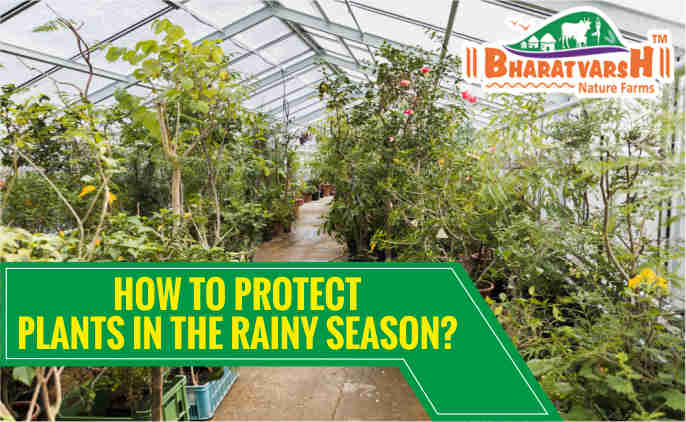People and plants both like the monsoon (rainy season). Monsoon season is known to alter different emotions in people. It is also the most fantastic time to enjoy the gorgeous colors in the garden, balcony, and so on. The Monsoon season is a happy time of year for gardeners who like seeing their plants develop quickly and blossom in the rain. It’s not only the rain during monsoon season, but also the fresh and crisp air that blows all the day. The humidity in the air is also highly beneficial for plants.However, plants need specific care to protect them from the elements such as cold and virus infections,very much like people.
To protect the plants well,one needs to take care of following few points during the monsoon time:
1. Maintain Water Runoff
Water accumulation is the first most visible threat for the plants. Letting water gather in your garden will soak into the soil, ultimately drowning the roots and killing the plants.
Therefore, it is mandatory to construct a channel to divert surplus water from your yard into a drainage or gathering area, so that you can protect your plants from standing water.
2. Dose of Water
It is not suggested to water the plants during monsoon season until the soil droppings of the leaves are dry. Even if you want to water the plants, ensure to give just enough water to keep the plants healthy.
3. Garden Rain Cover
The next step is to shield your garden from the extra natural rainfall. If your garden is in an open location having majority of plants in the open, you must consider to provide them a rain cover.
A large tarp that doesn’t allow too much water to soak through it can be placed around your plants. All the fragile tiny plants and flowers in the open garden should be covered with tarp.
4. Wind protection with some assistance
Strong winds may occasionally accompany heavy rainfall during monsoon. These strong winds are considerably more dangerous to your plants since they can uproot your weakest plants while severely injuring the others.
You must secure the plants and your trellises with additional support and ties to rescue them from monsoon winds. Add some more rays,if you think they are required. Cover smaller plants in pots with cages or similar structures to protect them or move them inside.
5. Remove all of the damaged parts.
This action may be taken before, during, and even after heavy destructive rain. If you see any browning shoots or limbs that appear weak and about to fall off, take them off right away. It will keep the disease from spreading to other plant sections and give your plant a fair chance of recovering after the monsoon season.
6. Remove the weeds
During the rains, weeds may grow quickly and absorb the nutrients meant for your plants. As a result, keep weeding at regular intervals to prevent their hazardous development.
7. Make space in your landscape for light.
light becomes a source of concern during the monsoons season, particularly if you have plants that need sunshine. Using artificial light sources in your garden invites excessive monsoon insects.Use can choose some yellow bulbs or LED lights with low wattage to eliminate these insects. Allow some frogs or toads to enter your home plantings to help keep insects at bay.
8. Stop soil erosion.
Rainwater may promote soil erosion, exposing roots and impeding plant development. Create a barrier around plants to keep soil from eroding but remember that this barrier should not cause water logging.
9. You Should Use Pesticides
Pests may consume all of your new saplings and young plants or intrude on the soil’s nutrients. Sprinkle insecticides sparingly to eliminate these pests in time, particularly after pruning when new shoots emerge.
10. Avoid Snails
While the monsoon season delivers plenty of rain, it also comes with some unwelcome visitors like snails, which are dangerous for your plants. Snails like fragile plants and therefore, a new garden is a good target for their feeding activities. Snails feed at night since they are nocturnal creatures. You may not notice the presence of snails in your garden until you witness the harm they inflict. When massive, ragged holes appear on leaves, you will become aware of their existence.
Using salt is one of the simplest methods to keep snails away from plants. Planting neem leaves and cloves around plants can also help keep them away.
To Summarize
Monsoon season is a period for development and blossom for your home garden, but you must take specific measures. While rain eliminates the need to water your plants daily, still you must do your part if you like your home garden. This article covers some suggestions on how to care for your home garden during the rainy season. If you are still concerned about the effects of the monsoon on your plants, do reach Bharatvarsh Nature Farms Nursery and ask for the expert visit to maintain of your garden well. You can also get organic fertilizers ( Vermicompost, Cow Urine, Cow dung cake, Jeevamrut ), and organic pesticides ( Neemastra, Agniastra, Bramastra, Panchgavya and Dashparni ark ). The additional effort you put in today will undoubtedly pay off tomorrow!
Contact Bharatvarsh Nature farms :
You can reach us for some useful gardening tips to grow your own organic garden. If you already have one, contact us for supply of these natural products for your rooftop garden, lawn or organic farm.
For more details, please visit our website: https://bharatvarshnaturefarms.com/
Write to us at: info@bharatvarshnaturefarms.com or call us at: 91-8603214214, 8650214214
Learn more : Tips to successfully manage and grow a dairy farm – Bharatvarsh Nature Farms




